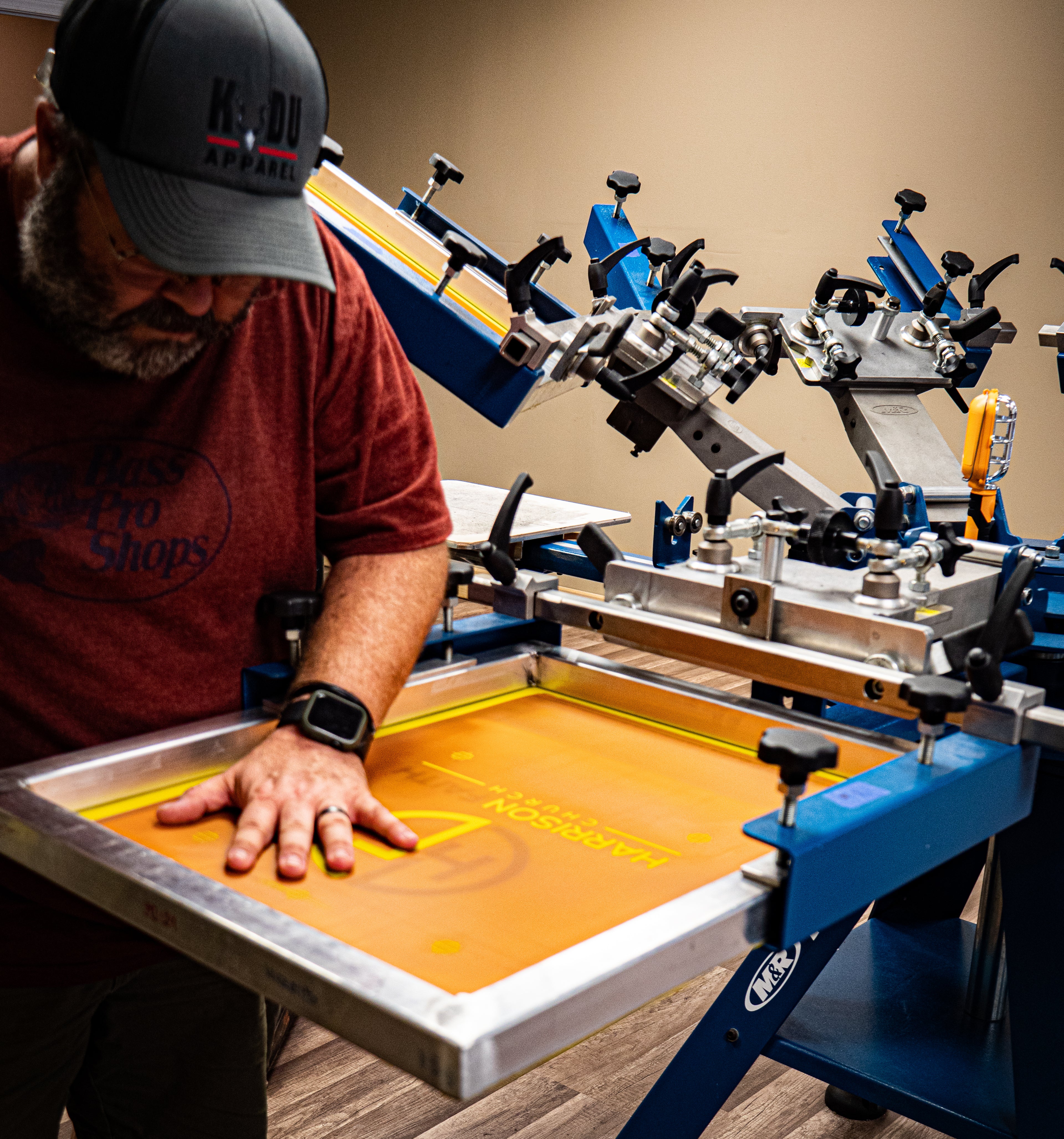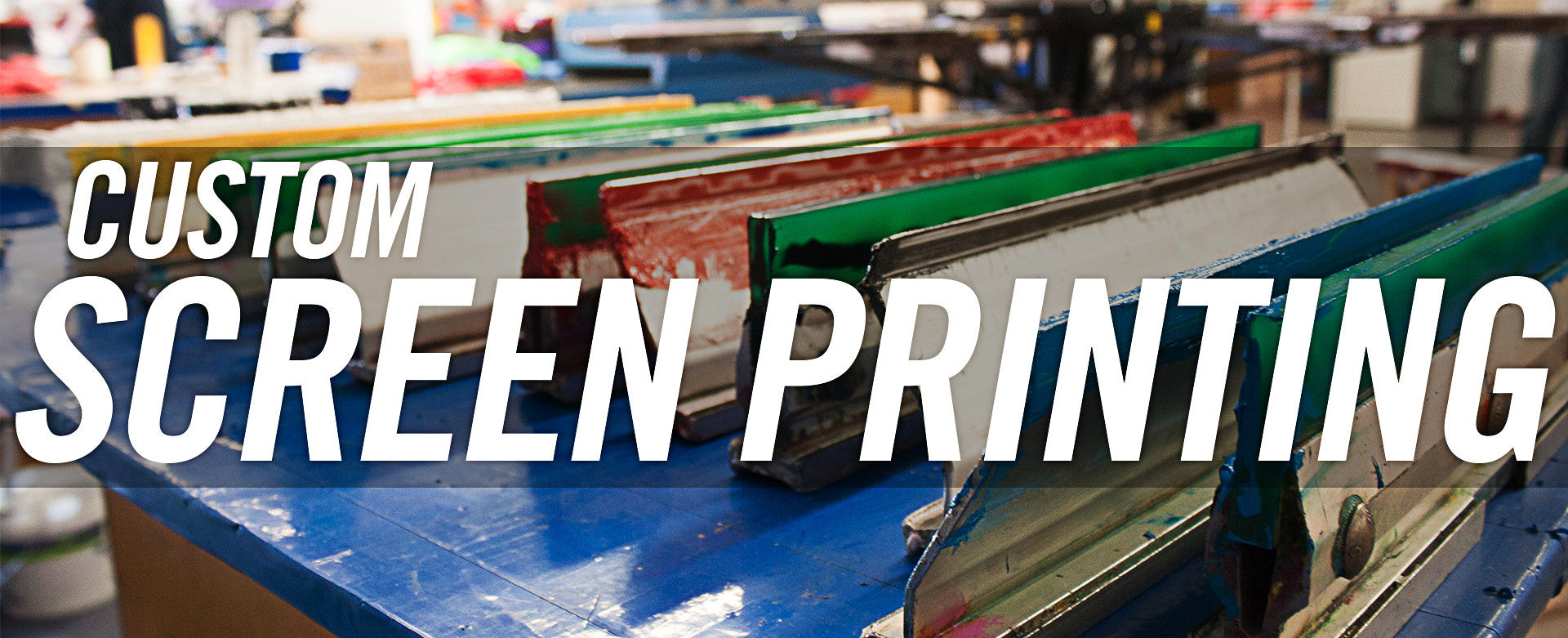High-Volume T-Shirt Printing for Schools and Organizations
High-Volume T-Shirt Printing for Schools and Organizations
Blog Article
Display Printing Uncovered: Everything You Need to Understand About Tee Shirt and Garment Printing Methods
Display printing is a remarkable method that combines art with strategy, supplying limitless possibilities for creative thinking. All set to discover the crucial elements that make display printing an art form?
The Essentials of Display Printing: Exactly How It Functions
When you plunge right into display printing, you'll find it's both an art and a scientific research. At its core, screen printing involves creating a stencil, or display, that permits ink to travel through just in details areas (screen printing kit). You start by choosing your style and preparing your display with a light-sensitive emulsion. As soon as you expose this emulsion to light, it solidifies, leaving your design as an adverse space.
Position the display over the fabric, after that make use of a squeegee to push ink with the display onto the garment. Each step is necessary, and mastering them will certainly elevate your display printing skills, transforming easy garments right into distinct, expressive items.
Types of Screen Printing Methods
As soon as you realize the essentials of screen printing, it's time to discover the various techniques that can boost your designs. One preferred approach is typical display printing, where ink is pushed via a stenciled display. This technique is wonderful for vibrant, vibrant shades. There's water-based ink printing, which offers a softer feel and is environmentally friendly, however it needs a different method to curing.
If you're going for great details, think about discharge printing. This method eliminates color from the fabric, leaving a soft, classic look. One more option is plastisol printing, known for its durability and brilliant shades, making it a favored for lots of brands. Finally, try out halftone printing to produce gradient effects and complex styles. Each technique has its unique charm, so do not be reluctant to attempt them out to locate what suits your design best!
Crucial Devices for Screen Printing
To attain spectacular outcomes in screen printing, having the best devices is essential. You'll need a tough screen printing framework, which holds the mesh that transfers your style onto the garment. Next, invest in high-quality mops; these are important for applying ink evenly throughout the screen.
Choosing the Right Inks and Products
When selecting inks and products for display printing, you require to take into consideration the type of ink that works finest for your task. Consider fabric compatibility to guarantee your styles look last and terrific lengthy. Discover eco-friendly ink options to make your printing process more sustainable.
Types of Display Inks
Choosing the ideal display ink is necessary for accomplishing vibrant, durable prints that satisfy your job's needs. There are a number of kinds of screen inks to check out. Plastisol ink is preferred for its convenience and simplicity of usage, offering superb color opacity on dark materials. Water-based ink, on the various other hand, uses a softer feeling and is environment-friendly, making it ideal for those seeking to minimize their environmental impact. Release inks get rid of color from the material, leading to a soft, vintage appearance however need specific handling. Specialized inks, such as glow-in-the-dark or metallic, can add one-of-a-kind impacts to your designs. Evaluate your project demands and pick the ink that aligns ideal with your desired result.

Material Compatibility Considerations
Comprehending material compatibility is vital for accomplishing high-quality screen prints, especially considering that various products react distinctively to various inks. Constantly test your inks on example material to assure they adhere appropriately and preserve shade integrity. In addition, maintain in mind that textile weight and texture can affect the final outcome, so picking the ideal ink and product combo is important for your job's success.
Eco-Friendly Ink Options
Eco-friendly inks are becoming a preferred selection for display printers who intend to decrease their environmental effect while maintaining quality. When selecting inks, consider water-based inks, which are much less unsafe and much easier to cleanse up compared to traditional solvents. These inks bond well with textiles, delivering vibrant outcomes without hazardous chemicals. You could additionally discover eco-solvent inks that utilize less unstable natural substances (VOCs), making them a much safer option for both your wellness and the planet.
Furthermore, look for inks made from renewable sources, such as soy or vegetable-based choices. By selecting the appropriate inks and products, you'll not just develop magnificent layouts but also add to a much more lasting printing procedure. Make the switch, and your prints will certainly show your dedication to the setting!
Preparing Your Design for Screen Printing

File Style Needs
To guarantee your design looks sharp and vibrant on fabric, you'll need to pay close attention to submit style needs for display printing. Make certain your style Visit Website has a transparent history to protect against unwanted white sides on your prints. Keep shade modes in mind; CMYK is typical for display printing, so convert your RGB creates accordingly.
Color Separation Strategies
Shade separation is an essential step in preparing your layout for screen printing, and grasping it can considerably enhance your print high quality. You'll need to break your layout into private shades, as each shade requires a separate display during printing. This accuracy not just assures exact shade depiction but likewise simplifies the printing process.
Resolution and Size
Attaining the finest lead to display printing starts with guaranteeing your design has the appropriate resolution and size. Ideally, your art work needs to be at the very least 300 DPI (dots per inch) for sharp, clear prints. If you make use of reduced resolution, your end product might look pixelated and amateur.
When it pertains to dimension, think about the dimensions of your print location. Layout your artwork to match the last print dimension, preferably creating it in the actual measurements you'll be publishing. By doing this, you'll prevent any type of unexpected scaling concerns.
Always inspect your design in both vector and raster styles. Vector graphics can be scaled without shedding high quality, making them perfect for screen printing. Preparing properly will guarantee your style looks impressive on every garment!
Step-by-Step Screen Printing Process
Display printing is a dynamic process that permits you to produce vivid layouts on different surfaces. To begin, you'll need a screen, emulsion, and your chosen ink. First, prepare your screen by cleaning it thoroughly. Next off, apply the solution uniformly and allow it dry in a dark area. As soon as completely dry, reveal your screen to light with your style put on it, which will solidify the solution where the light hits, developing a pattern - screen printing kit.
Put ink onto the screen and use a squeegee to press the ink with the stencil onto the textile. Raise the display meticulously and allow the print dry. You have actually successfully screen published your style.
Tips for Effective Screen Printing Projects
While you're diving right into your display printing projects, bear in mind that prep work is crucial to success. Begin by collecting all your products-- inks, screens, garments, and squeegees. A clean workspace aids prevent undesirable errors, so clean prior to you you could try here start.
Next, validate your artwork is high-resolution and appropriately sized for your garment. Check your display for correct direct exposure and clean it thoroughly to stay clear of spots. When blending your inks, follow the manufacturer's standards to achieve the right consistency.
During printing, apply also stress with your squeegee for constant outcomes. Do not rush; take your time to confirm each print fulfills your standards. After printing, allow your garments dry entirely before managing or packaging them.
Lastly, always keep a sample of your help future recommendation. This means, you can evaluate your progression and enhance your techniques over time. Delighted printing!

Often Asked Concerns
How much time Does It Take to Establish a Screen Printing Task?
Setting up a screen printing task usually takes about thirty minutes to an hour. You'll prepare the screens, mix inks, and readjust journalism. The time varies based on intricacy and experience, so stay arranged!
Can I Print on Various Textile Keys In Utilizing the Same Strategy?
Yes, you go to my site can print on different textile types using the exact same strategy, but you'll need to readjust your inks and settings. Some materials take in ink in different ways, so exploring guarantees the best outcomes for each and every material.
What Are Common Mistakes to Avoid in Screen Printing?
When display printing, stay clear of typical errors like making use of the incorrect ink, ignoring appropriate exposure times, or skipping pre-press checks. Always examine your setup and maintain clean screens to assure quality outcomes each time.
Exactly How Can I Appropriately Clean and Preserve My Display Printing Equipment?
To appropriately clean and preserve your display printing tools, you ought to frequently wash screens with suitable solvents, examine mops for wear, and ensure all tools are stored completely dry and dust-free. Consistency boosts and avoids expensive repairs performance.
Is Display Printing Eco Friendly Compared to Other Methods?
Display printing can be a lot more eco pleasant than other approaches, particularly if you utilize eco-conscious materials and water-based inks. By selecting sustainable products and methods, you reduce waste and reduce your influence on the earth.
Display Printing Uncovered: Every Little Thing You Need to Know Concerning Tee and Garment Printing Techniques
At its core, display printing involves creating a pattern, or display, that allows ink to pass through just in details locations. Placement the screen over the fabric, after that make use of a squeegee to push ink with the display onto the garment. One prominent approach is standard display printing, where ink is pressed with a stenciled display.When choosing inks and materials for screen printing, you require to take right into account the type of ink that functions best for your job.
Report this page